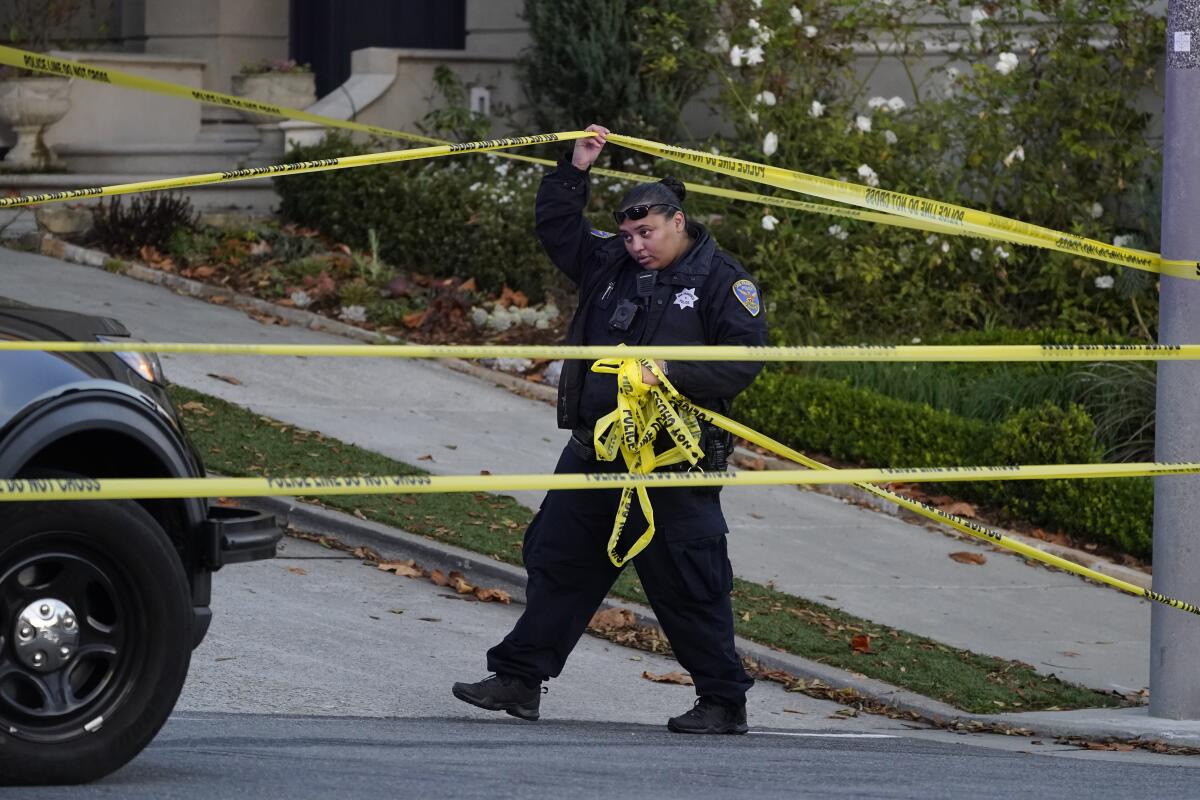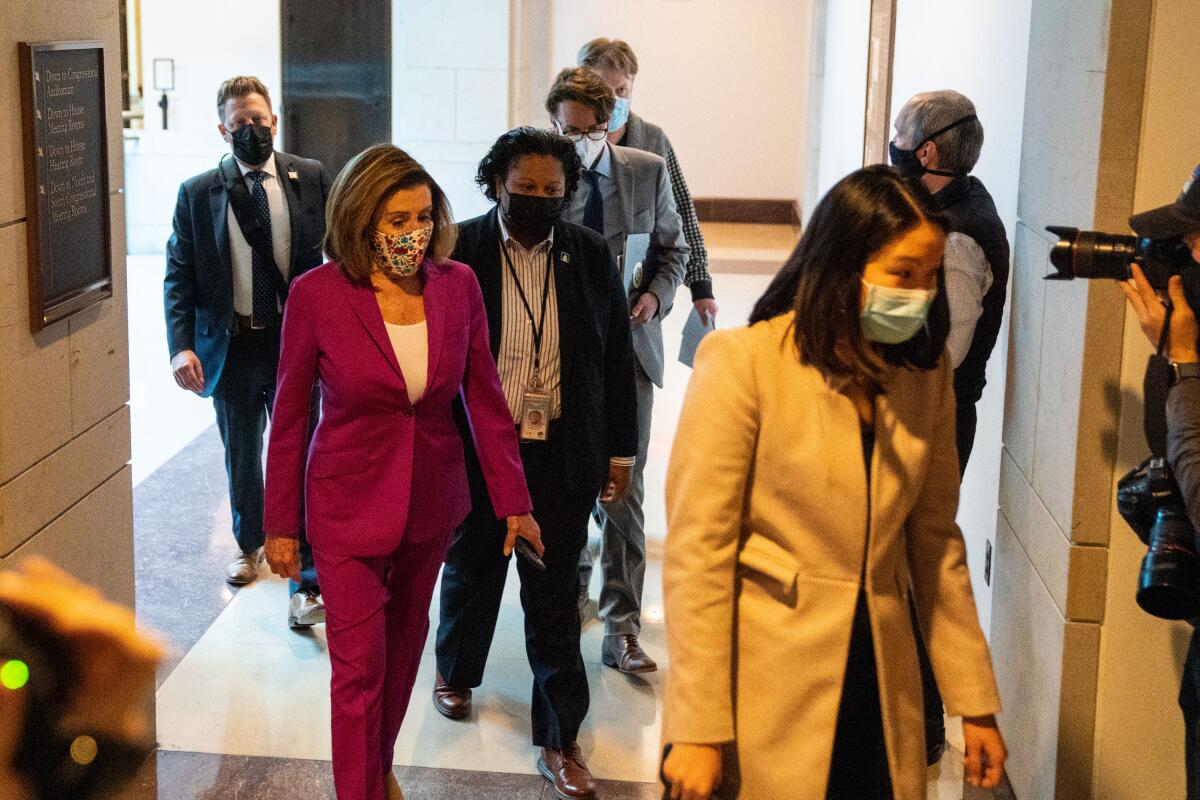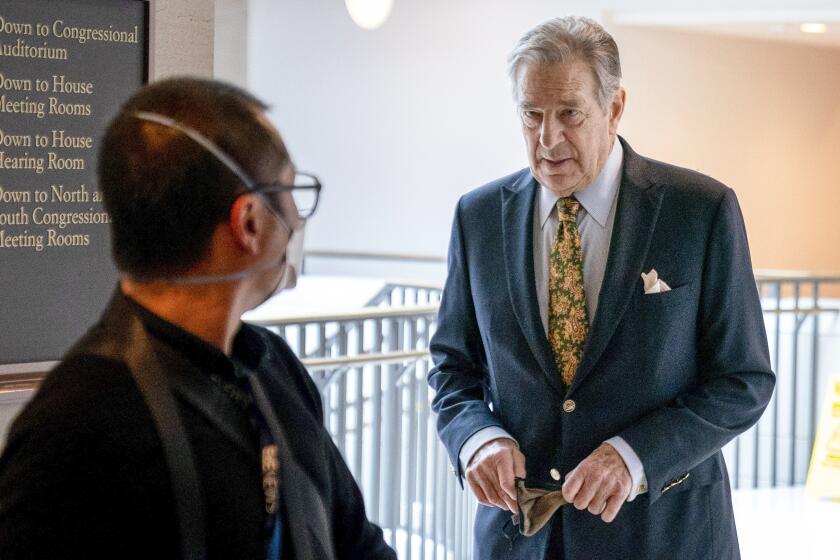Alleged attacker asked for Nancy Pelosi before beating her husband with hammer

The assailant reportedly yelled, “Where is Nancy?” The attack comes 11 days before the midterm election and raises concerns about increased threats against public officials.
Calling out for “Nancy,” an intruder who forced his way into the San Francisco home of the U.S. House speaker early Friday had a target in mind, authorities said, before he attacked her husband and fractured his skull with a hammer.
Paul Pelosi, 82, is recovering from surgery at Zuckerberg San Francisco General Hospital “to repair a skull fracture and serious injuries to his right arm and hands,” said Drew Hammill, a spokesperson for Speaker Nancy Pelosi’s office. He is expected to recover fully.
Although the attacker’s motive remains undetermined, the violence — 11 days ahead of the midterm election — has sparked alarm in part because of heightened concern about the safety of public officials at their homes and offices. Those worries have compounded in the wake of the Jan. 6, 2021, attack on the U.S. Capitol, where Nancy Pelosi was one of the targets.
A source who was briefed on the Friday attack said the assailant shouted, “Where is Nancy? Where is Nancy?” before confronting Paul Pelosi.
“Based on our investigation at this point … this was not a random act,” San Francisco Police Chief Bill Scott said during a news conference Friday evening. “This was intentional.”
Scott identified the suspect as David DePape, 42, and said officers responded to the Pelosi home around 2:27 a.m.
At the start of the break-in, Paul Pelosi told the intruder that he had to use the bathroom, then made a surreptitious 911 call on his cellphone and left the line open, sources familiar with the attack told The Times. Dispatcher Heather Grimes could hear Pelosi talking to his attacker and alerted officers to the scene.
“It is really thanks to Mr. Pelosi having the ability to be able to make that call and truly the attention and instincts of that dispatcher to realize that something was wrong and to make the police call a priority,” San Francisco Dist. Atty. Brooke Jenkins told CNN, adding that officers got to the scene in two minutes.
Scott praised Grimes’ quick thinking.
“She had to interpret what she was being told,” he said at the news conference. “And based on her experience and intuition, she basically figured out that there was something more to this incident than what she was being told. Her actions, in my opinion, resulted in both a higher-priority dispatch and a faster police response.”
Paul Pelosi, the husband of U.S. Speaker of the House Nancy Pelosi and a longtime businessman, was attacked Friday morning at his home in San Francisco.
When police arrived and knocked on the front door, Scott said, someone inside opened the door. The officers saw Paul Pelosi and DePape, “each with one hand on a single hammer,” he said.
After officers ordered both men to drop the hammer, DePape “immediately” pulled the tool from Pelosi and “violently attacked him with the hammer,” Scott said.
Police tackled DePape, grabbed the hammer and took him into custody before calling for backup and beginning first aid.

At some point after police arrived, DePape said he was “waiting for Nancy,” a law enforcement source told The Times.
After DePape was taken to a hospital, he was booked Friday afternoon on suspicion of attempted murder, first-degree burglary, assault with a deadly weapon, threatening a family member of a public official, elder abuse, battery with serious bodily injury, dissuading a witness and injuring a wireless device.
Scott confirmed that DePape had “forced entry” into a rear door of the Pelosi home.
Jenkins, the San Francisco district attorney, said her office is “working closely” with authorities “and will proceed with the appropriate charges as things unfold.”

Nancy Pelosi was in Washington, D.C., with her protective detail at the time of the break-in, according to the U.S. Capitol Police.
“The speaker and her family are grateful to the first responders and medical professionals involved, and request privacy at this time,” her office said in a statement.
A Times review of his online accounts show David DePape had been drifting further into the world of far-right conspiracies, antisemitism and hate.
In a personal blog that DePape maintained, posts include such topics as “Manipulation of History,” “Holohoax” and “It’s OK to be white.” He mentioned 4chan, a favorite message board of the far right. He posted videos about conspiracies involving COVID-19 vaccines and the war in Ukraine being a ploy for Jewish people to buy land.
DePape’s screeds included posts about QAnon, an unfounded theory that former President Trump is at war with a cabal of Satan-worshipping elites who run a child sex ring and control the world. In an Aug. 23 entry titled “Q,” DePape wrote: “Either Q is Trump himself or Q is the deepstate moles within Trumps inner circle.”
President Biden spoke with the congresswoman Friday morning “to express his support after this horrible attack,” Karine Jean-Pierre, the White House press secretary, said in a statement.
Vice President Kamala Harris, speaking in Philadelphia with Biden, said: “I pray for Paul’s recovery. I know the Pelosis, and this is tragic. Somebody literally broke into their home saying, ‘Where’s Nancy?’”
Biden linked the attack to a worrying rise in political violence.
“Enough is enough is enough,” the president said in Philadelphia. “Every person of good conscience needs to clearly and unambiguously stand up against the violence in our politics.”
The U.S. Capitol Police said in a statement that it has sent special agents and threat assessment investigators to the scene and is assisting the FBI and San Francisco police.

The Pelosis live in Pacific Heights, one of San Francisco’s most exclusive neighborhoods. On Friday, police blocked off the street outside the home.
John Braun, who has lived in San Francisco for 50 years, lamented the attack as he walked his dog nearby, while helicopters buzzed overhead.
“Nobody should be attacked in their homes,” he said. “Nobody should be attacked anywhere.”
Deborah Karel, who has lived in the neighborhood for three decades, said she was “horrified” by the assault.
“That anyone would go after our political leaders ... but also just common people that they don’t agree with ... I feel like this is one of the many things that keeps happening that makes me very worried about democracy,” she said.
“I’m 72, and I’ve never been this worried. It never occurred to me that democracy might fail. But now it does. And this seems related.”
Aerial footage of the Pelosi home showed a back patio door with shattered glass.
Images of the four-bedroom brick home, built in 1938, are regularly featured on conservative websites. The house has been the site of protests; last year, someone used black spray paint to write “A,” for “anarchy,” on the garage door, and a severed pig’s head was left in front of the home.

The assault comes at a tense time in the U.S., which is grappling ahead of the midterms with bitter partisanship and a widespread belief in political conspiracy theories — including about the legitimacy of the 2020 presidential election — that have led to violence and threats against politicians, election workers and other public figures.
Democratic politicians on Friday were quick to blame the attack on hyper-partisanship and divisive political rhetoric.
“This heinous assault is yet another example of the dangerous consequences of the divisive and hateful rhetoric that is putting lives at risk and undermining our very democracy and Democratic institutions,” California Gov. Gavin Newsom said in a statement. “Those who are using their platforms to incite violence must be held to account.”
“Our leaders should never fear for their safety and the safety of their families in serving the people they were elected to represent — not in their homes, not at the U.S. Capitol, not anywhere.”
State Sen. Scott Wiener (D-San Francisco) said in a statement that the assault was “terrifying, and the direct result of toxic right-wing rhetoric and incitement against Speaker Pelosi and so many other progressive leaders.”
“Words have consequences,” he added, “and without question, the GOP’s hate and extremism has bred political violence.”
Meanwhile, conservatives tried to paint the attack as an example of rising crime — a key issue in the midterm election.
The attack at the Pelosi home in San Francisco is one in a string of incidents affecting members of Congress and their families this year.
Nathan Hochman, a Republican defense attorney and former federal prosecutor who is running to unseat California’s Democratic attorney general, Rob Bonta, showed up outside Pelosi’s home Friday morning.
Standing beside police tape blocking the street, he told a Times reporter that the incident was an example of rampant crime in California.
“If Paul Pelosi can’t be safe in his home in San Francisco, how can anyone be safe?” Hochman said. “This is a continuum of a spiral of lawlessness. Enough is enough.”
Political violence has been on the rise in California and across the nation.
In June, a Simi Valley man was charged with attempted murder of a U.S. Supreme Court justice after being found with a gun, knife and pepper spray near the Maryland home of Justice Brett M. Kavanaugh.
Last month, Rep. Karen Bass’ (D-Los Angeles) mayoral campaign announced that the congresswoman’s home “had been broken into and burglarized.” She said two firearms that were “safely and securely stored” were stolen.
In Northern California, a San Ramon man was convicted on multiple gun charges, including having a concealed firearm in his care, after threatening the life of Wiener last month.
Erik Triana, 51, was arrested after he sent Wiener a threat through the state senator’s “contact me” website portal that read: “Vax my kids without my permission and expect a visit from me and my rifle.”
In May, a Napa man, Ian Rogers, 46, pleaded guilty to conspiring to destroy a building by fire or explosives and possession of a machine gun after plotting to firebomb the Democratic headquarters in Sacramento.
The hammer attack on House Speaker Nancy Pelosi’s husband at their San Francisco home grew out of a culture that rewards stridency and provocation.
Threats against members of Congress have increased dramatically over the last five years, according to data from the Capitol Police — from 3,939 cases in 2017 to 9,625 cases in 2021.
During the first three months of 2022, the latest period for which data are available, Capitol Police have opened roughly 1,820 cases, the agency said.
Capitol Police said in an email to The Times that, for safety reasons, the department “does not discuss potential security measures for Members.”
The attack on Pelosi came a day after the Department of Homeland Security and the FBI issued a report saying that investigations involving domestic violent extremism nearly doubled from 2020 to 2021.
The agencies said that in 2020, the FBI was conducting about 1,400 domestic terrorism investigations. By the end of 2021, it was conducting about 2,700. A “significant portion” of the investigations last year were “directly related to the unlawful activities during the January 2021 siege on the U.S. Capitol,” the report says.
Wiley reported from San Francisco, Petri from New York, and Winton and Yee from Los Angeles. Times staff writers Hailey Branson-Potts and Nolan D. McCaskill contributed to this report.
More to Read
Start your day right
Sign up for Essential California for news, features and recommendations from the L.A. Times and beyond in your inbox six days a week.
You may occasionally receive promotional content from the Los Angeles Times.












